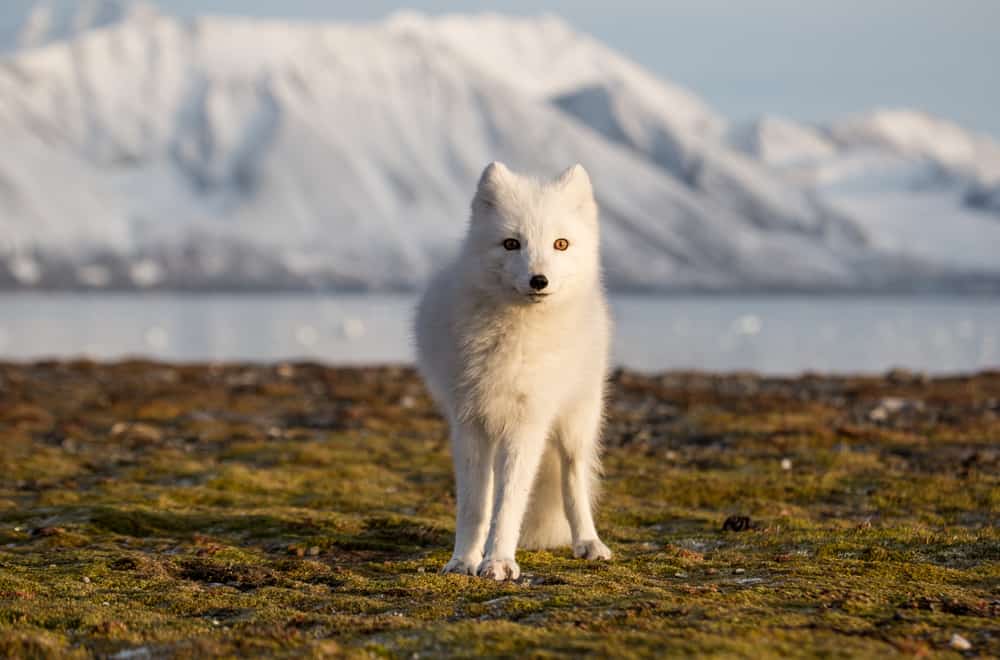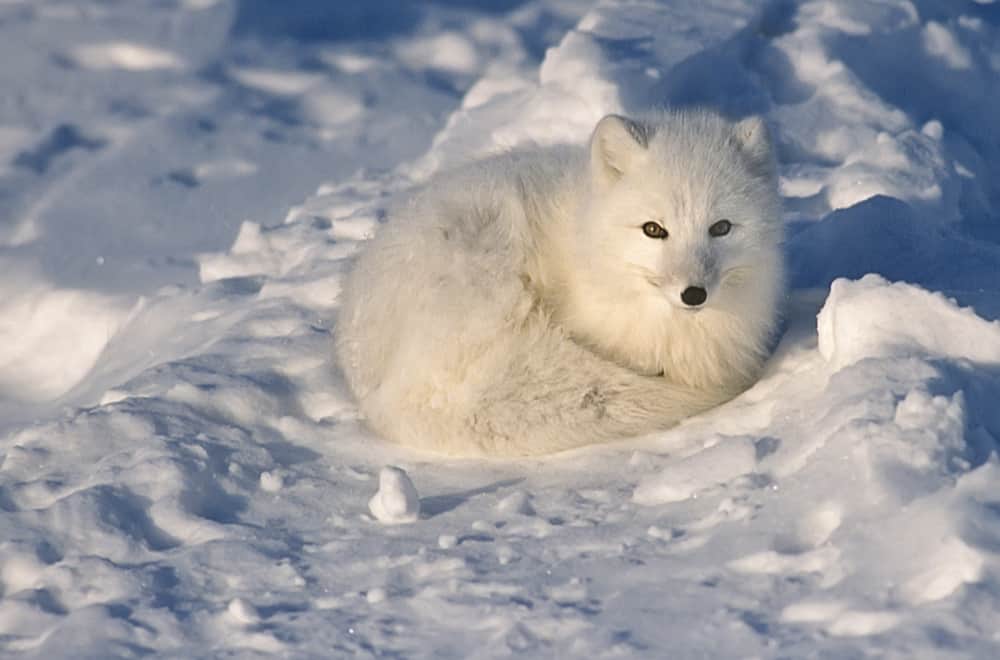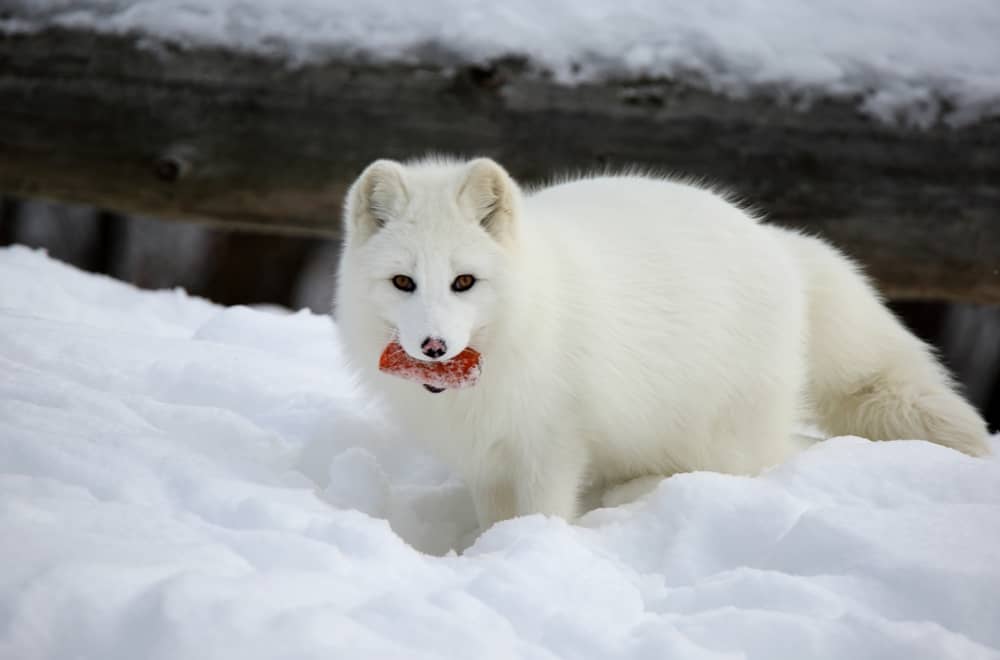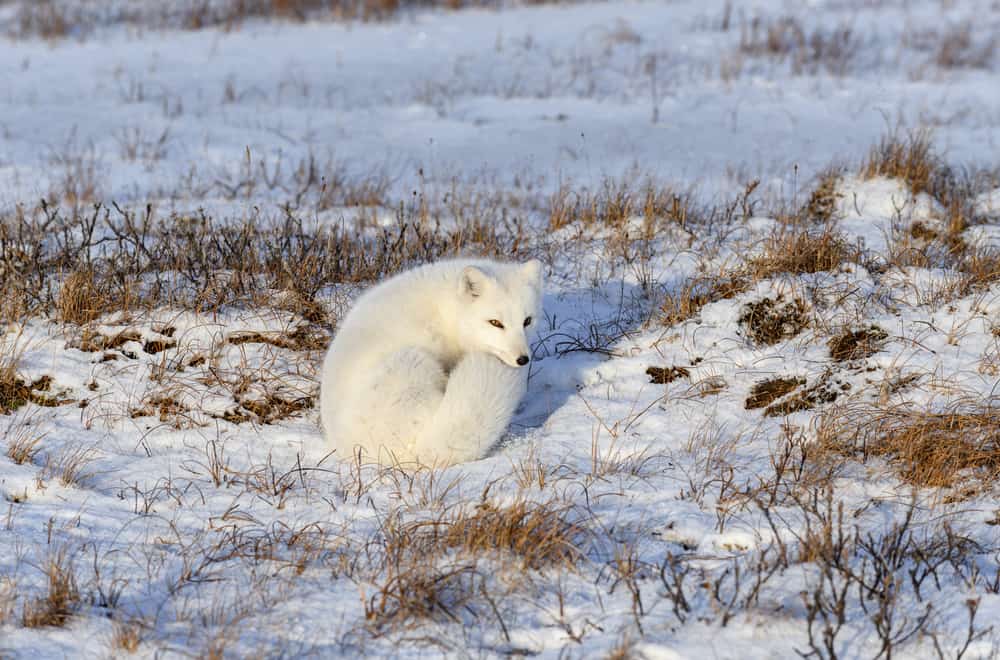Keeping an Arctic Fox as a pet means that you are truly keeping a wild, exotic pet. That’s always something that you have to remember and be aware of when you’re around them.
With that being said, they can make great pets to the right owner. They are smart, clean, beautiful, social animals who you can make a genuine bond with.
Arctic Fox Habits and Biology
As their name would imply, Arctic Foxes live in the Northern Hemisphere’s Arctic Tundra. They are usually between a foot and a half and just over two feet long, and they have thick white fur that helps them blend into snow. That thick fur doesn’t just help them blend into snow, but keeps them warm in the cold arctic climate, as does their rounded shape.
While naturally evolved to handle the cold weather, arctic foxes have other tricks to stay warm. For instance, they’re excellent diggers who will burrow underground in severe weather. They’re also capable of lowering their metabolic rate, or the rate of energy expenditure, to retain warmth.
As the seasons change, they do tend to lose their trademark white fur. This is because the white is used as camouflage in snow, and during the months when snow clears from parts of the tundra, it would become ineffective.
Instead, their fur turns gray to blend with the rest of the tundra. This camouflage is important to the Arctic Fox, as plenty of larger animals do prey upon them, like bears, eagles, and wolves. On the other hand, it also helps them hide from their prey as they hunt.
Today, due to factors ranging from over hunting to loss of habitat, to loss of prey, Arctic Foxes are facing plenty of challenges. However, they aren’t listed as being endangered. They reach maturity at about ten months old and live to eleven years on the older age range in the wild.
Do Arctic Foxes Eat Dirt?
No, Arctic Foxes don’t eat dirt. Arctic Foxes are omnivores who prefer to stick to a mostly carnivorous diet, which dirt doesn’t factor into.
What Do Arctic Foxes Like to Eat the Most?
Living in the Arctic Tundra, Arctic Foxes have become adept predators who hunt small rodents extremely well. Their favorites include lemmings and voles. However, their diet doesn’t end there. Birds and fish are also on the menu when rodents aren’t otherwise available. If given the opportunity, and in need of food, Arctic Foxes will even hunt seal pups. However, that is less common for them as they’re a more difficult prey.
Being omnivores, wild Arctic Foxes will eat more than just meat. They’re known to go after nests and eat eggs, as well as berries and seaweed when available. They tend to hoard food and build body fat for the winter months.
Keeping an Arctic Fox as a pet isn’t like keeping a dog as a pet. They’re simply not domesticated in the same way, which also means that you can’t simply feed them dog food. However, there are several premium dog foods that you can feed an Arctic Fox that when blended with water, eggs, and berries can constitute a well-balanced diet.
You may also want to consider feeding them small rodents, but this can be difficult to figure out how much you actually need to feed them, so that they receive all the nutrients they need. It’s also important to remember that if you choose to feed your pet Arctic Fox meat, feed it a full rodent. It needs the organs for its diet.
Here are a few brands of food that you can feed them, when mixed with supplementary eggs and berries:
Instinct Raw Boost
Instinct Raw Boost is a grain free, high protein dry food option. It comes in multiple flavors, so if your Arctic Fox doesn’t like the beef, you can also choose from chicken, duck, or salmon.
The real reason this is a great option for your Arctic Fox, however, is the ingredients that Instinct Raw Boost is made with. Because it lacks fillers and preservatives, it’s healthier than other options, while its high protein levels make it exceptional for your Arctic Fox’s health.
As the name implies, Instinct Raw Boost comes with frozen, raw ingredients. These are added to the dry food, helping to round out your Arctic Fox’s diet.
Blue Buffalo
Blue Buffalo is a fairly well known and regarded brand. Like Instinct, they offer numerous flavors for your Arctic Wolf to choose from. However, their flavors tend to blend a protein like chicken with brown rice.
They take out the preservatives and put an emphasis on using real meat instead. This helps to create a high protein diet for your Arctic Wolf. Blue Buffalo also likes to point out that their blend includes antioxidants and vitamins that your Arctic Wolf will need.
Food to Avoid Feeding Arctic Foxes
More than just a regular omnivore, Arctic Foxes are also a scavenger. As a scavenger in the wild, they’ll eat almost anything.
Of course, this tends to be fairly limited in the Arctic Tundra. While most of their diet consists of small birds, eggs, and rodents, they’re also known to eat fruit and seaweed they have access to.
In other words, there’s not much that an Arctic Fox won’t eat. Still, there are a few things to avoid feeding your Arctic Fox.
- Cheap Dog Food – It might seem easier to get whatever is cheap for them at the store. Except, this isn’t healthy for them. Cheap dog foods are full of grains and other fillers to take up space. Frankly, they’re not what you should be feeding any dog, let alone an Arctic Fox, because they simply lack nutritional value. They can also lead to long term health issues for your Arctic Fox.
- Processed or Prepackaged Meats – If you choose to feed your dog meat, as their diet would primarily consist of this in the wild, you need to make sure to avoid feeding them processed meats. Like a cheap dog food, they simply lack nutritional value for your Arctic Fox. The same can be said for feeding your Arctic fox a piece of steak or ground turkey. Those are fine, but they don’t offer the full nutritional value that Arctic Foxes need.
Remember, avoid cutting corners on your Arctic Fox’s food, and find something that will give them the nutritional value they need. And, if you’re feeding your Arctic Fox meat, make sure to feed them a whole rodent or whole fish, so they can eat it in its entirety.
Tips to Feeding Arctic Foxes
When it comes to feeding an Arctic Fox, it’s first important to remember that they are not domesticated in the same way that dogs are domesticated. This means that you can’t simply feed them the way you might a dog. They need a well rounded diet that includes meat, eggs, and fruit. So, the first thing you need to do is to develop a high protein diet plan for them.
It’s also important to remember that depending on their age, Arctic Fox puppies need to be fed different amounts of times per day. Under three months, they’ll need four meals a day, but by the time that they’re one year old they typically only need one meal a day.
And, if you do choose to feed your Arctic Fox rodents or fish, you may want to do it outside to make cleaning up after them easier.
Frequently Asked Question
1. Is it legal to keep an Arctic Fox as a pet?
Being an exotic animal, there are different laws on whether you can keep an Arctic Fox as a pet, so it’s important to be in touch with the local regulation. However, for the most part it is perfectly legal to own an Arctic Fox in North America.
2. Can I feed my Arctic Fox dog food?
This depends on what dog food you’re interested in feeding your Arctic Fox. Anything that lacks a lot of preservatives and fillers, while being high in protein should be a good option as long as it’s not their only food source.
3. Do Arctic Fox pets eat wild animals?
If you Arctic Fox pet has access to small mammals or birds, it will likely attack them. After all, if a dog is going to chase a squirrel, what can you expect a non-domesticated animal like an Arctic Fox to do?
Even the best trained are going to want to chase for prey. Ask yourself the question, “What do Arctic Foxes eat?” And know that if they have access to one of those things they will take the chance to eat it.
Summary
The Arctic Fox is actually less common to keep as a pet than the more common Red Fox. Still, they make an excellent companion to you, so long as you’re capable of giving them the care and attention that they deserve.
So, take your time to properly train you Arctic Fox pet, make sure that it feels loved and a bond with you, and make sure that it is fed as well as possible.



